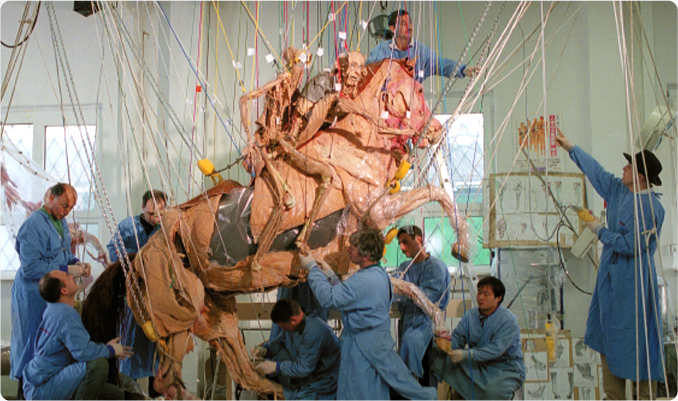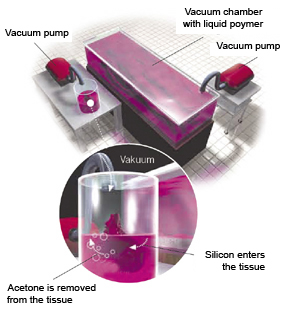What lies beneath our skin
Against the backdrop of plastinated human specimens at the Body Worlds and the Cycle of Life exhibition, Dr Angelina Whalley is the picture of animated health and vitality.

Dr Angelina Whalley stands with a woman on a swing at the ‘Body Worlds and the Cycle of Life’ exhibition, created by scientist
Dr Gunther von Hagens. Picture: Tracy Lee Stark.
Whalley is the conceptual planner and designer behind Body Worlds, and as she moves through the fascinating displays of plastinated human bodies and organs, her understated intelligence is evident.
“We had to cater for the layperson, who maybe doesn’t like seeing a drop of blood,” the quiet physician says with a smile.
“At our first exhibition we had all of the bodies standing straight up, and people kept saying ‘they look so dead’.”
Whalley has intimate knowledge of the story behind the exhibition – she is married to Dr Gunther van Hagens, the inventor of plastination technology, and was part of his team while they expanded on his prolific work in the preservation and presentation of the human body.

One of the exhibitions at the ‘Body Worlds and the Cycle of Life’ exhibition. Picture: Tracy lee Stark
“My husband invented this technology in 1978,” says Whalley.
“He’s invested his entire career into making it what it is today. It took years to develop the right polymer. The plastics provide stability to soft tissue. Otherwise the models would collapse. People thought we were a bit crazy. But I think you have to be a bit crazy to do what we do.”
Whalley’s love for her work is evident as she takes us through the exhibition. Even though she has probably given this tour on countless occasions, her face lights up as she talks about the displays, and she uses animated hand gestures to explain different concepts. She laughs when asked if working with her husband is a challenge.
“When we go home, we sometimes take our work problems with us, so there’s no time for rest. Fortunately our work has been so plentiful that while he continues with his research, I care for the conceptualisation and design of the exhibitions. Ever since we started these exhibitions, I’ve been trying to enhance them and make them more relevant. My husband is also always developing his research.”

One of the exhibitions at the ‘Body Worlds and the Cycle of Life’ exhibition. Picture: Tracy lee Stark
Whalley travels across the globe with Body Worlds. There are several expos which run at the same time, so there’s very little down time.
“I’m afraid that I work quite a bit,” she says.
“Fortunately I still love what I do. It’s very rewarding. Stress isn’t always a bad thing – you need some kind of stress to feel alive. But in my spare time I’m a passionate flamenco dancer.
“My motivation lies in educating lay people. It’s wonderful for doctors and even paramedics to see our work, but I think it’s really important for lay people to understand what they are made of. People leave here with a completely different view of their bodies.”
How does plastination work?
Embalming and Anatomical Dissection
The first step of the process involves halting decay by pumping formalin into the body through the arteries. Formalin kills all bacteria and chemically stops the decay of tissue. Using dissection tools, the skin, fatty and connective tissues are removed in order to prepare the individual anatomical structures.The Plastination process itself is based on two exchange processes.
Removal of Body Fat and Water
In the first step, the body water and soluble fats are dissolved from the body by placing it into a solvent bath (e.g., an acetone bath).
Forced Impregnation
This second exchange process is the central step in Plastination. During forced impregnation a reactive polymer, e.g., silicone rubber, replaces the acetone. To achieve this, the specimen is immersed in a polymer solution and placed in vacuum chamber. The vacuum removes the acetone from the specimen and helps the polymer to penetrate every last cell.
Positioning
After vacuum impregnation, the body is positioned as desired. Every single anatomical structure is properly aligned and fixed with the help of wires, needles, clamps and foam blocks.
Curing (Hardening)
In the final step, the specimen is hardened. Depending on the polymer used, this is done with gas, light or heat. Dissection and Plastination of an entire body requires about 1,500 working hours and normally takes about one year to complete.
Information and images courtesy http://bodyworlds.co.za












